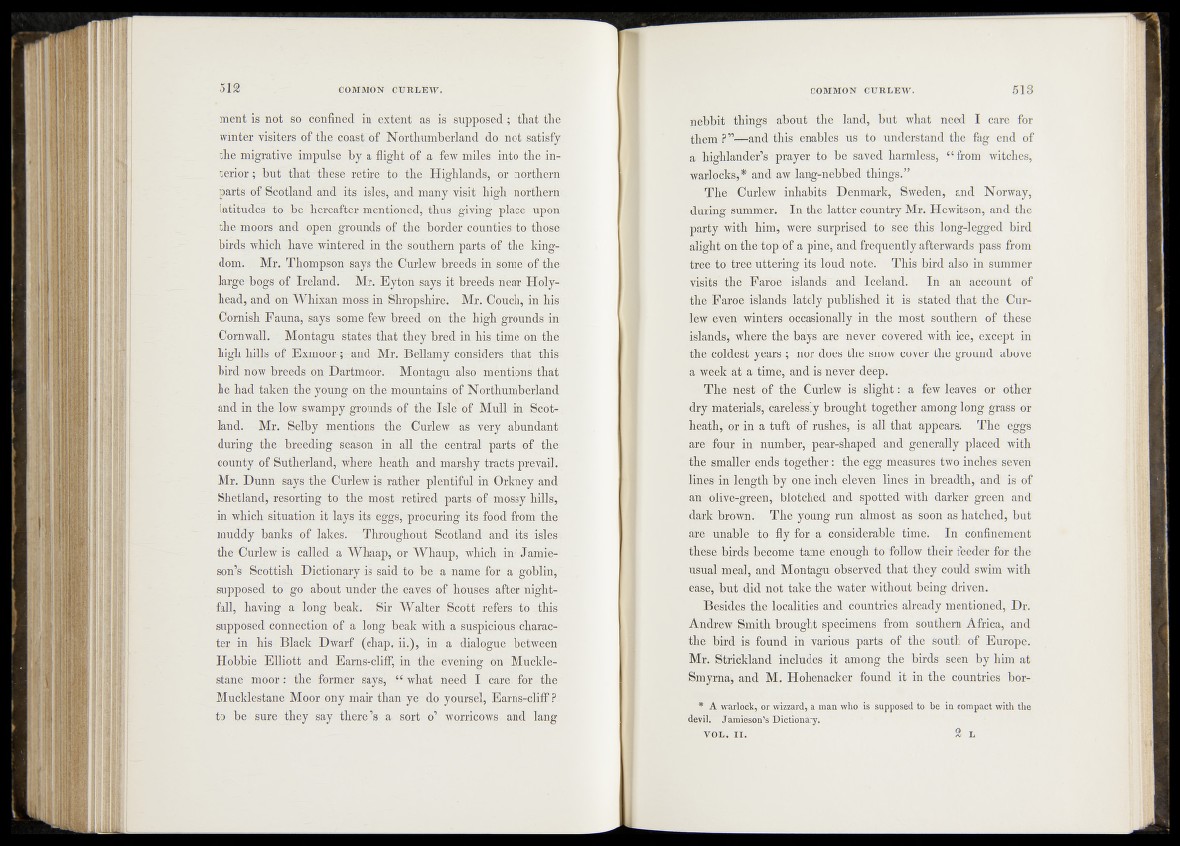
ment is not so confined in extent as is supposed; -that tHe
winter visiters of the coasCof. Northumberland do not satisfy
the migrative impulse By. a flight of r few.miles into the interior;
hat that-these-retire to the.. Highlands,- or northern
parts of Scotland and its dsle% and many visit high northern;
latitudes to be hereafter mentioned,' thus giving place „-upon
the moors and open' grounds of the border cou-ntiesHo 'thp'sel
birds "which "have wintered in the southern parts of the' kingdom.
Mr. Thompson says the Curled breeds/in some' ofithe;
large-bogs of Ireland. Mr. Eyton .says it breeds near Holy--'
head, and on* Whixan moss’in Shropshire. Mr. ^phch/dn his
Cornish Fauna, says some few breed>:on - thediigh grounds in
Cornwall. Montagu states that they bred in his .time -p^the'
high hills: of Exmoor-^-and- Mr. "Bellamy considers that th is;
bird now-breeds on Dartmoo'r: Montagu also mehtittfs’ that
he had taken the young on the mountains ^p^Ii^rthumb-erland
and in the low swampy grounds of-' the J§pPt>.f Mull' inlScpt--,
land. Mr. Selby mentions the Curlew^g. wery abundant-
during the-breeding Season in all the -central parts of the
county of Sutherland,;^hefe'.:heath and marshy tr.n L-Vj'i i_\ ail.*s
Mr. Dunn -says'the Curlew is, rather plentiful in Orkneyan d
Shetland, .resorting to the most retired parts of mos-} lull -V*j
inifivKhich situation it lays itsf^ggs^ procuring its food from the
muddy banks of lakes. “Throughout Se.utla’n d a n d < ’itf-4isfes^
the-Curlew is called a Whaap, or- WKaup, which in' 'JiaH^e-'
son’s Scottish Dictionary is said to be a name, for a goblin,-
supposed to go about under the eaves-of houses afterUiight-
fall, having a long beak. Sir . Walter Scott7refers • to Jhis'
supposed connection of a long beak with a suspicious-character
in: his Black Dwarf (chap. ik),'4n>^a dialogue between-
Hobbie Elliott and Eams-clifF, in the ^veiling on Muckle-
stane moor : the former says, what need I care, for . th e '
Mucklestane Moor ony mair than yfeydo yoursel, Earns-cliff ?,
to /be sure they say there’s a- sort o’4 worricows. and lang
nebbit things about the land, but what need I care for
them ?”—and this enables us to understand the fag end of
a highlander’s prayer to be saved harmless, “ from witches,
warlocks,* and awJang-nebbed things.”
The CurleW inhabits Denmark, Sweden, and Norway,
during summpfj(i In the latter country Mr. Hewitson, and the
party--with him,.were surprised to' see this long-legged bird
alight on théï top of a pine^and frequently afterwards pass from
tree- to tre'e uttering its; loud?nrof® This bird also'in summer
visits’ the' Faroe4 (islands“ and''Iceland. In an account of
the Fardé, islands lately« published it is stated that the Curlew
even winters" occasionally dn the most southern of these
islands, where the bays-are never, covered with ice, except in
thëi’G’öldest years ; nor"-doe’s: the snowr cover the ground abo've
a week* at a time; and is never dd|j# :.^
The neskof the Curlew* is - slight: a few leaves or other
dry materials, carelessly brought together among long grass or
heath, or in a tuft n f rushes^fis all that appears; The eggs
are^ibur inphumber, pear-shaped and generally1 placed with
the smaller ends>‘togèf|mr: theff|g|^easures two inches seveif
lines'in length by one inch e|8|.ën lines in breadth, and is óf
am-oM^e-green, blotched and spotted with darker- green and
dark-brown.- The young-- run almost as-soon as hatched, but
are "/unable to fly fbr-ttf considerable" time. In confinement
these birds be'Come tame enPUgËAöTbllow their feeder for the
usual‘meal,; and Montagu? observed* that they 'cóUM swiin with
ease, but did not take- the water- without being driven.
Besides, the. iocalitie^ind ’countries already mentioned, Dr.
Andrew Smith brought .specimens from southern Africa, and
the bird is found in'various parts of the south of Europe.
Mr. Strickland includes it among thé birds seen by him at
Smyrna^ and M. Hohenacker found -it? in the countries bor-
* A warlock, or.wizzard, a man who is supposed to be in compact with the
devil. Jamieson’s IJictiohaiy. T
'7ypL,, f l . 2 L